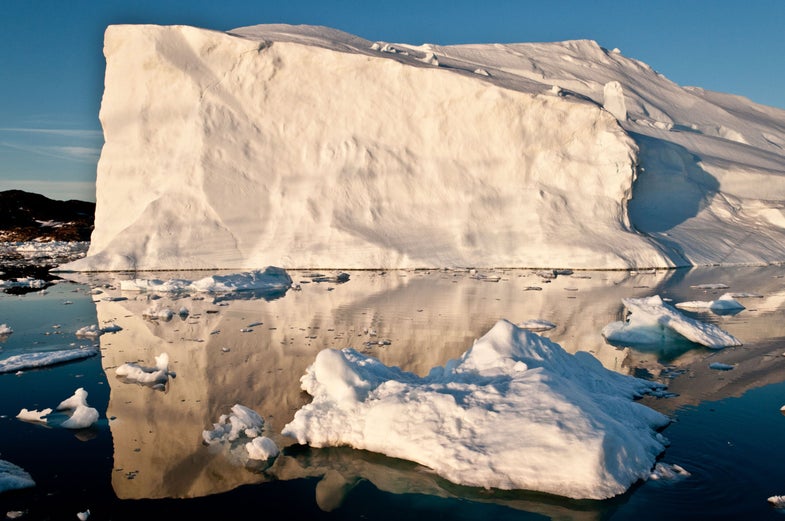Scientists Find Clearest Evidence Yet Of Monumental Polar Ice Melt
A landmark study refines measurements of losses in Greenland and Antarctica and how ice melt is contributing to rising seas. Here's why that is important.

_
Click to launch a stunning photo gallery of melting ice in Greenland and Antarctica_
All of the ice sheets in the world except one are losing prodigious mass, according to a landmark new survey of satellite data. Greenland and Antarctica are now losing more than three times as much ice as they were in the 1990s. Greenland alone is shedding more ice-mass today than it was in 1992 by a factor of five. And since 1992, ice loss from the Greenland and Antarctic ice sheets has contributed to an 11-millimeter rise in sea levels, the new study says.
“As the climate warms, we’re going to lose more mass and the losses will be higher by the end of the century,” said Ian Joughin, senior principal scientist at the Polar Science Center Applied Physics Lab at the University of Washington and a co-author. “From any 20-year record, and this 20-year record in particular, we just can’t at this point extrapolate. But we can see that the trend is towards increases, and that that’s something we do need to worry about.”
These cold numbers are the clearest evidence yet of Earth’s warming polar regions, more than twice as accurate as the numbers in the Nobel Peace Prize-winning 2007 IPCC climate report. To come up with these statistics, 47 scientists from 26 institutions used 50 combined years of data from 10 different satellites.
Why is this important?
Previous estimates of ice-sheet loss have been shaky at best, with widespread variation in different studies of Greenland and Antarctica since 1998. These disparate estimates make it difficult to nail down solid data for climate models–it’s not clear how much ice is being lost, and just when and where. Some studies have even suggested certain areas are gaining ice, creating uncertainty about Earth’s ice “mass balance.” This was especially true in Antarctica.
“While most studies agree that ice sheets are losing mass in most places and in aggregate, the precise rate has been much more difficult to determine,” explained Jesse Smith, senior editor of the journal Science, which publishes the paper today. “That’s where this study makes its mark.”
The research team, led by University of Leeds professor Andrew Shepherd, combined several types of data sets and methods and re-processed the records, ensuring they were comparing apples to apples. No one had ever done this before; previously, scientists using each ice-measurement method released independent estimates for different locations.
What did they do?
Measuring ice loss happens in a number of ways. Satellite laser and radar instruments measure the height of ice caps, and other instruments can measure the gravitational influence of ice sheets. This is a supremely complicated measurement involving an accounting of Earth’s mantle and how the ice weighs it down.
Global positioning satellites assisted here, by detecting just one millimeter per year of motion. This dramatically refined the gravity effect of ice in Antarctica, in particular. Scientists even used nuclear physics to examine changes inside rocks in Antarctica, which can tell how long the rocks were exposed to the sun as opposed to buried in ice.
The study correlated data from the same places and times, and discarded some outlying observations that couldn’t be cross-checked. The refined and combined measurements are clearer than ever, and show that most of Antarctica–not to mention Greenland–is indeed losing ice. The authors say East Antarctica is gaining some ice, but not nearly enough to compensate for losses in West Antarctica and the Antarctic peninsula.
The study shows the importance of a reliable satellite network, many scientists said. Without cross-calibrated observational tools, this type of measurement would be much more difficult–and many of the planet’s eyes in the sky, including satellites owned by NASA and ESA, are aging and even failing.
“We need to not just make snapshots, but we need to make sustained measurements, preferably through a coordinated international effort,” Joughin said.
What does it mean?
Better data will be used to make better models of future climate, allowing scientists to more accurately predict how polar ice may continue to melt. Shepherd said he hoped United Nations members meeting in Doha, Qatar this week would take the study to heart. He also said he hoped climate scientists would start incorporating the new data into their models as soon as possible–it’s available today.
“We would hope that people would adopt this as the universal record,” he said.
But the physics of glaciers, waves, sea circulation and other variables are still not well understood, Joughin pointed out. Climate scientists still want more and better data on these phenomena, as well as the ice sheets, to improve their models. “Just as economists can say that the stock market will likely be higher in 2100, they can’t say exactly how high or at what rate, and they can’t really just take any 20-year period and extrapolate that and expect to get the right answer,” Joughin said. “That’s really what’s going on [here].” Still, it’s safe to say we now have clear evidence the seas are rising.

Disko Bay, Greenland

Glacial Meltwater

A Grand Glacier Canyon

Supraglacial Lake

Ilulissat Fjord, Greenland

Greenland Ice Sheet Margin

Pine Island Glacier

Gathering Antarctic Rock Samples

Polar Winter Coming